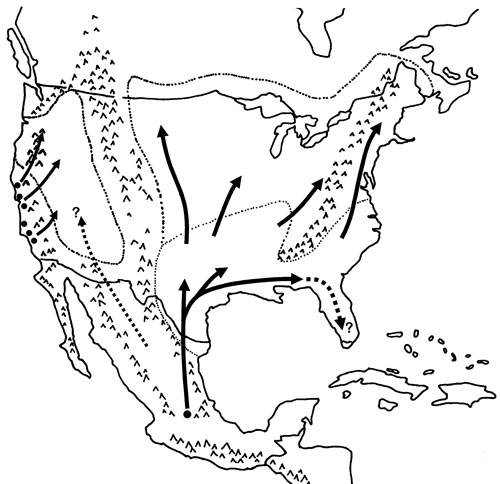Spring Migration Ecology
 Monarch butterflies begin to leave their Mexican wintering sites in mid-March, and have usually all departed by the end of March. At this point, many of them have already mated, but both sexes leave the sites and migrate north and mating continues throughout the journey north. Malcolm et al. (1993) and Cockrell et al (1993) reported the dates of first sightings of eggs, larvae and the larval host plants of adult monarchs arriving at different latitudes in eastern North America. These papers established the general pattern of spring movement and demonstrated that recolonization of the northern ranges of the breeding habitat occurs over two generations. The monarchs that overwinter in Mexico fly north to repopulate the southern half of the US, and their offspring complete the journey to the northern US and southern Canada. This second generation recolonizes the entire northern breeding range, utilizing more northern milkweed species (See Figure 15).
Monarch butterflies begin to leave their Mexican wintering sites in mid-March, and have usually all departed by the end of March. At this point, many of them have already mated, but both sexes leave the sites and migrate north and mating continues throughout the journey north. Malcolm et al. (1993) and Cockrell et al (1993) reported the dates of first sightings of eggs, larvae and the larval host plants of adult monarchs arriving at different latitudes in eastern North America. These papers established the general pattern of spring movement and demonstrated that recolonization of the northern ranges of the breeding habitat occurs over two generations. The monarchs that overwinter in Mexico fly north to repopulate the southern half of the US, and their offspring complete the journey to the northern US and southern Canada. This second generation recolonizes the entire northern breeding range, utilizing more northern milkweed species (See Figure 15).
Spring migratory routes are considerably more difficult to identify and study than fall routes because in the spring monarchs are dispersed and consequently less noticeable than the fall migrants which form spectacular roosts. We are still learning a great deal about this portion of the monarchs’ annual cycle from individuals that report their monarch observations as part of Citizen Science programs, such as Journey North (Howard and Davis 2004). This program involves school children and other interested individuals from every US state and seven Canadian provinces, who report their first sightings of monarch butterflies every spring. Through these reports, we can learn about when and where monarchs travel as they migrate north in the spring.
Howard and Davis (2004) described the patterns of spring migration and monarch abundance based on data collected by Journey North participants over a 6-year period from 1997 to 2002. They found a striking regularity of the migratory pattern from year to year, although the average arrival date at different latitudes and the duration of migration varied between years. They suggest that this annual variation may stem from differences in environmental conditions or timing of milkweed emergence, and are continuing to investigate these factors using additional data collected by Journey North participants.
